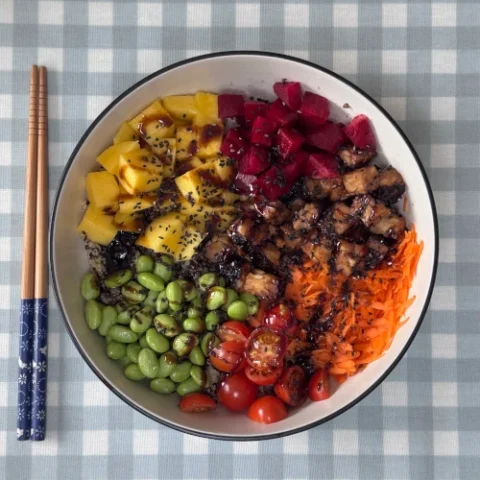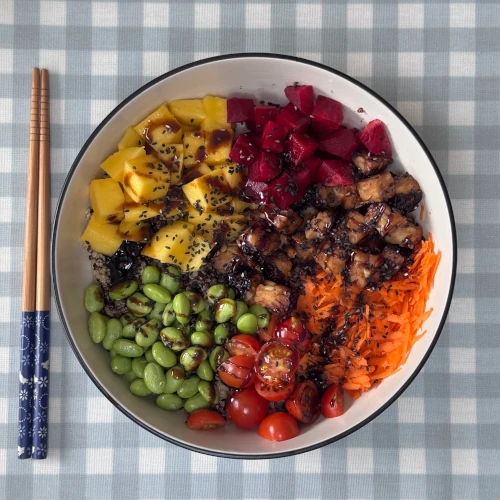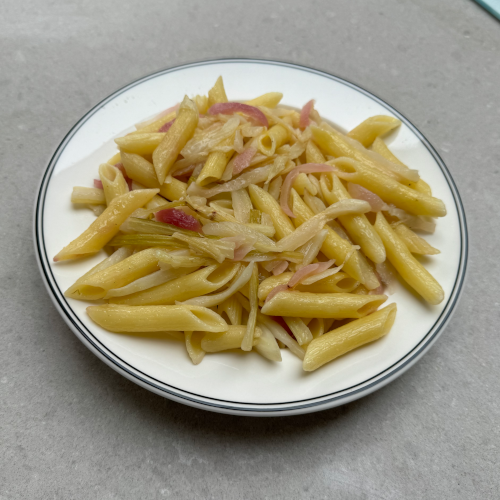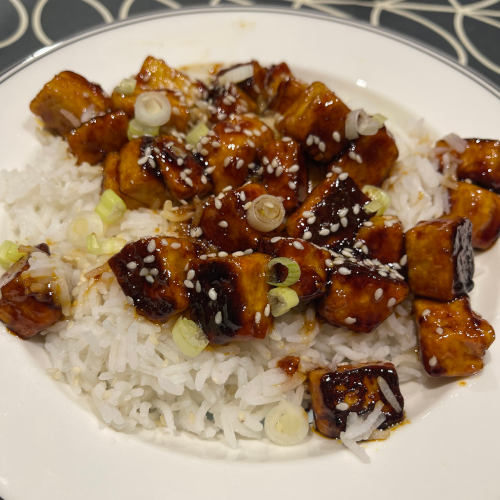
Quinoa teriyaki tempeh poke bowl with mango
A vibrant, nutrient-dense poke bowl with quinoa, tempeh, fresh vegetables, and sweet mango, finished with teriyaki sauce for a wholesome plant-based meal.
Ingredients
- Quinoa (cooked) – 120 g (½ cup, from ~40 g dry)
- Tempeh – 100 g, cubed
- Cherry tomatoes – 80 g (6–7, halved)
- Beetroot (cooked) – 70 g (½ medium, diced or grated)
- Edamame (shelled) – 80 g (½ cup)
- Carrot – 50 g (½ medium, grated or spiralised)
- Mango – 100 g (½ small mango, diced)
- Teriyaki sauce – 2 tbsp (30 ml)
- Sesame seeds – 1 tsp (optional)
- Spring onion – 10 g (finely chopped, optional)
Instructions
- Cook quinoa: rinse 40 g quinoa, simmer with 100 ml water for 10–12 minutes until fluffy. Let cool slightly.
- Prepare tempeh: cube and pan-fry with 1 tbsp teriyaki sauce until golden.
- Chop vegetables and fruit: halve cherry tomatoes, dice beetroot and mango, grate carrot, cook edamame if frozen.
- Assemble: add quinoa as a base, then arrange tempeh, vegetables, and mango in sections.
- Finish: drizzle with the remaining 1 tbsp teriyaki sauce and garnish with sesame seeds and spring onion.
Nutrition Information:
Yield: 1 Serving Size: 1Amount Per Serving: Calories: 609Total Fat: 20gSaturated Fat: 5gTrans Fat: 0gUnsaturated Fat: 13gCholesterol: 0mgSodium: 1497mgCarbohydrates: 77gFiber: 14gSugar: 31gProtein: 41g
Teriyaki tempeh has become a star ingredient in the world of plant-based poke bowls, bringing a savoury-sweet depth of flavour that pairs beautifully with quinoa, edamame, and fresh vegetables. In recent years, the poke bowl has become a beloved staple of healthy eating around the world. Originally from Hawaii, the dish has travelled far from its island roots and evolved into countless variations that reflect local tastes and ingredients. At its heart, poke (pronounced poh-keh, meaning “to slice” or “cut crosswise” in Hawaiian) is a celebration of freshness, balance, and nourishment.
Hawaiian origins
Traditional poke bowls trace their origins to Hawaiian fishermen, who would season the offcuts of their catch — often tuna or octopus — with salt, seaweed, and roasted kukui nuts. This simple preparation provided a quick and flavourful meal, highlighting the natural quality of fresh fish available on the islands. Over time, Japanese and other Asian influences introduced soy sauce, sesame oil, and rice as key components, further shaping what we now recognise as the classic poke bowl.
The modern twist with teriyaki tempeh
As the dish spread beyond Hawaii, especially to mainland America and Europe, it underwent a significant transformation. Modern poke bowls are highly customisable, often built around a base of rice or quinoa, topped with proteins such as salmon, tuna, chicken, or plant-based alternatives like tempeh and tofu. A rainbow of vegetables, fruit, sauces, and seeds complete the bowl, making it both visually appealing and nutritionally balanced.
The beauty of the poke bowl lies in its flexibility. It can be tailored to suit vegan, vegetarian, or omnivorous diets without compromising flavour or satisfaction. In this sense, it shares similarities with salads and Buddha bowls, but with a distinctly Hawaiian flair.
Nutritional benefits of teriyaki tempeh poke bowls
Poke bowls are more than just Instagram-worthy meals — they are packed with nutrients. A well-constructed bowl typically includes:
-
Complex carbohydrates: bases such as brown rice or quinoa provide sustained energy release.
-
Lean protein: traditional fish or plant-based proteins like tempeh, tofu, or edamame support muscle repair and satiety.
-
Healthy fats: avocado, sesame seeds, or a drizzle of sesame oil contribute heart-healthy omega-3s and omega-6s.
-
Micronutrients: fresh vegetables and fruits, from mango to beetroot, add vitamins, minerals, and antioxidants that support immunity and overall health.
According to the Harvard School of Public Health, soy-based foods like tempeh are linked to improved heart health and reduced cholesterol.
Cultural significance
While poke has become a global food trend, it remains deeply tied to Hawaiian culture. For locals, it represents more than just nourishment — it is a reminder of community, respect for the ocean, and the island’s multicultural history. The modern adaptations may look different, but they pay homage to the original ethos of fresh, simple, and seasonal eating.
Why teriyaki tempeh poke bowls resonate today
In a fast-paced world, poke bowls tick many boxes: they are quick to assemble, highly nutritious, and endlessly versatile. They fit neatly into the broader trend of “bowl food”, where entire meals are composed in one dish, easy to transport and easy to enjoy on the go.
For those following plant-based diets, vegan adaptations like quinoa with tempeh, mango, and colourful vegetables provide the same sense of variety and indulgence as traditional versions. Each bowl is a canvas for creativity — a way to eat healthily without feeling restricted.
You may also like exploring more tempeh recipes for inspiration.
Conclusion
The poke bowl has journeyed from the shores of Hawaii to dining tables worldwide, winning hearts with its balance of flavour, colour, and nutrition. Whether enjoyed in its traditional form with fresh fish or reimagined with plant-based ingredients, it remains a dish rooted in freshness and cultural heritage. For health-conscious eaters, it is more than just a trend — it is a delicious and nourishing lifestyle choice.







